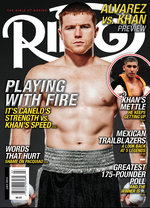From THE RING Magazine: The building of Canelo
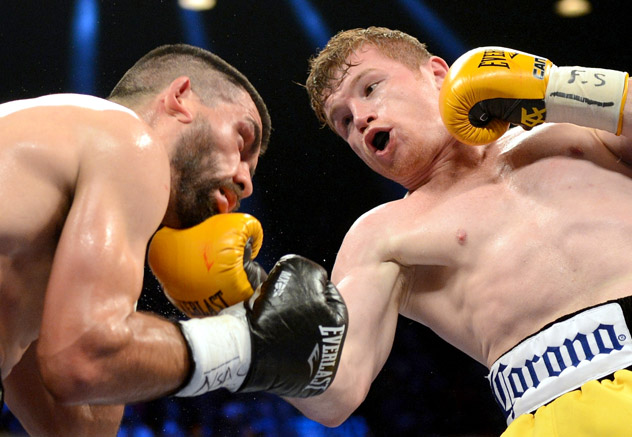
GOLDEN BOY HAS NAVIGATED DELICATELY BETWEEN RISK AND REWARD IN CREATING THE BURGEONING FACE OF BOXING
This story appears in the July 2016 edition of THE RING Magazine.
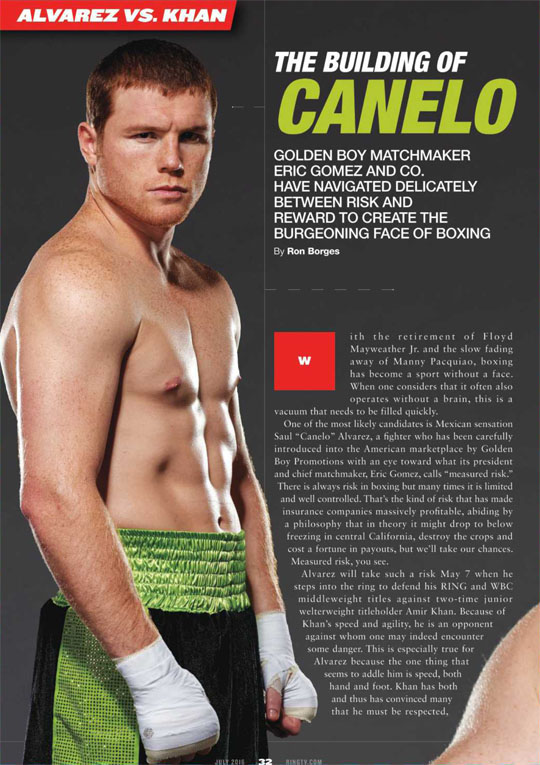 With the retirement of Floyd Mayweather Jr. and the slow fading away of Manny Pacquiao, boxing has become a sport without a face. When one considers that it often also operates without a brain, this is a vacuum that needs to be filled quickly.
With the retirement of Floyd Mayweather Jr. and the slow fading away of Manny Pacquiao, boxing has become a sport without a face. When one considers that it often also operates without a brain, this is a vacuum that needs to be filled quickly.
One of the most likely candidates is Mexican sensation Saul “Canelo” Alvarez, a fighter who has been carefully introduced into the American marketplace by Golden Boy Promotions with an eye toward what its president and chief matchmaker, Eric Gomez, calls “measured risk.” There is always risk in boxing but many times it is limited and well controlled. That’s the kind of risk that has made insurance companies massively profitable, abiding by a philosophy that in theory it might drop to below freezing in central California, destroy the crops and cost a fortune in payouts, but we’ll take our chances. Measured risk, you see.
Alvarez will take such a risk May 7 when he steps into the ring to defend his RING and WBC middleweight titles against two-time junior welterweight titleholder Amir Khan. Because of Khan’s speed and agility, he is an opponent against whom one may indeed encounter some danger. This is especially true for Alvarez because the one thing that seems to addle him is speed, both hand and foot. Khan has both and thus has convinced many that he must be respected, if not exactly feared, by Alvarez and those around him.
Gomez, who along with his boss and boyhood friend, Oscar De La Hoya, made the match, doesn’t disagree. He insists that risk comes with the territory if the aim is to make competitive fights fans want to see. But, again, there is risk and then there is “measured risk,” which is how he and De La Hoya saw the Khan fight while it was being debated internally.
“Oscar is modeling his company and developing Canelo after his own career,” Gomez explained. “One thing he believes is that good fighters will perform better when their opponent is better. So you take measured risks.
“When you’re developing a fighter you get them to a certain point and then you have to turn them loose to sink or swim. We know what Canelo means to our company. He’s our franchise. But Oscar believes in fights where you know your guy is in position to win but it will be tough. That’s the way we looked at the Khan fight.
“You look at this speed and you know speed is what gives Canelo the most problems. Khan has that and he’s bigger than Floyd Mayweather, who beat Canelo with speed. So it’s a risk. Some people don’t see that but it’s a risk. I wanted the fight but I have questions in my own head about the speed and how Canelo will handle it.”
To a degree that may be a promotional company talking to spur interest in what Las Vegas sees as a fight with strong odds favoring Alvarez, but the larger point is this: There is a thin line between risk and disaster when developing a fighter. The former is not only acceptable but at times necessary if one hopes to turn a boxer into the face of his sport. The other, however, can fracture his face and his future. This is the thin line Gomez and Golden Boy had to walk to get to the point where, if things go as expected, Alvarez’s next fight could be a huge pay-per-view showdown with undefeated middleweight champion Gennady Golovkin.
Your job sometimes is to protect a guy from himself. At the same time, if he really wants the fight, you can’t keep saying ‘not now’ because you run the risk he starts doubting your faith in him. – Don Chargin
That is a fight with a lot of risk, but some risks cannot be avoided because the reward is such that there is no choice. Fights like Tunney-Dempsey, Louis-Schmeling, Hagler-Hearns, Pacquiao-Marquez, Tyson-Holyfield and the many others that live on long after being contested are the lifeblood of the sport. Yet they are also the matches that put a boxer at great risk and hence are not something promoters want to constantly have their fighter facing.
The balance between too little risk and too much is one Gomez and Golden Boy have been striving for ever since they first promoted Alvarez on Oct. 24, 2008, at the Morongo Casino in Southern California against Larry Mosley. Mosley was a decorated amateur and a fleet-footed though light-hitting professional. He was a test Alvarez passed, although he had some early problems with Mosley’s movement.
The truer test came three fights later in Zapopan, Mexico, when Gomez matched him against an undefeated guy named Euri Gonzalez. Gomez had worked with Gonzalez previously so he knew what he was putting young Alvarez in with: a tough guy with fast hands. That night told the story. At least the early chapters.
“Canelo got hit with a big right hand along the ropes about halfway through the fight,” Gomez recalled. “He got hurt but he came roaring back and he stopped him late (in the 11th round of a minor title fight). We thought then we had something special. When he got hit with that right hand he reacted! He sold out the arena and he reacted to trouble the way you want your guy to react. He was raw but we thought we had something special.”
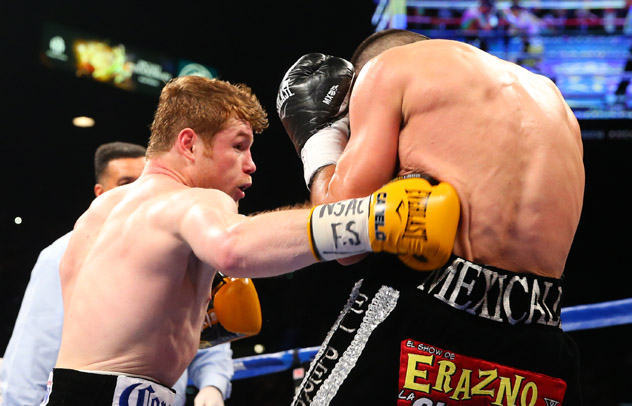
Photo by Ed Mulholland
Turns out they were right. Within 18 months he’d beaten former world champion Carlos Baldomir and in just over two years won the vacant WBC junior middleweight title by easily outpointing Matthew Hatton. By that time, the red-headed Alvarez had become a phenomenon in Mexico but remained relatively underappreciated in the U.S.
His reputation in the U.S. was built in traditional fashion, facing somewhat faded fighters with marketable reputations like Lovemore Ndou, Kermit Cintron and then the classic test against a once-great former champion who was a managed risk but a considerable one. That former champion was Shane Mosley, smaller and fraying around the edges but still someone who could expose a young fighter’s flaws if he was not ready to meet the challenge.
Gomez understood this but the risk seemed manageable and Alvarez won easily. A year later a less manageable risk was taken when he stepped in against Austin Trout, the undefeated former titleholder.
One matchmaker didn’t want anything to do with it.
Don Chargin promoted his first fight on Sept. 3, 1951, and his latest one about 20 minutes ago, so it is safe to say the 88-year-old Hall of Fame promoter and matchmaker understands the dark art and delicate balancing act of building a young fighter into a ticket-selling phenomenon. It is something he has done for decades, so it is with some admiration that he has watched his latest promotional proteges, De La Hoya and Gomez, build Alvarez into a phenomenon on the cusp of becoming the face of the sport. But he also understood that with a superior talent like Alvarez comes some unique problems, not the least being the fighter himself.
I felt Canelo was ready for the Floyd fight. I thought he was too big and too strong. I thought he would overwhelm him. Oscar felt he wasn’t ready yet. – Eric Gomez
“Canelo is a little different than most guys,” said Chargin. “Most guys you bring along and they want easier fights but Canelo really wanted to fight the best. It was Canelo who insisted on the Mayweather fight when Golden Boy wanted to wait, which would have been right from a promoter’s standpoint. He’s the one who wanted Trout when nobody wanted to fight Trout.
“With a guy like that you have to be careful. Your job sometimes is to protect a guy from himself. At the same time, if he really wants the fight, you can’t keep saying ‘not now’ because you run the risk he starts doubting your faith in him.
“I would have hesitated with a guy like Austin Trout and (Erislandy) Lara. Canelo thought he could beat Trout but nobody wanted to fight him. He talked Golden Boy into it. That fight was more dangerous than Mayweather. If you lose to Mayweather, he probably doesn’t hurt you and so you lost a decision to the guy. Everybody loses a decision to the guy. But if you lose to someone like Trout or Lara, now you’ve got a problem.”
Especially if you made the match. Memory fades after a defeat. Suddenly fighters forget whose idea it was. That was the risk with Trout, whom Canelo easily outpointed, and later Lara, who came two fights after the Mayweather loss and against the wishes of Gomez.
“I felt Canelo was ready for the Floyd fight,” Gomez admitted. “I thought he was too big and too strong. I thought he would overwhelm him. Oscar felt he wasn’t ready yet. He thought he was too young but their coaches convinced Oscar, and I agreed. Ultimately we were wrong and Oscar was right but my mindset was Floyd was not going to be able to hurt Canelo. The only way he could win was by running.
 “So you look at the risk and you see it but the reward there was huge and the risk was not. So we took it. Canelo lost a majority decision but came out of that fight bigger than ever. More popular in Mexico and now popular in the U.S. too.”
“So you look at the risk and you see it but the reward there was huge and the risk was not. So we took it. Canelo lost a majority decision but came out of that fight bigger than ever. More popular in Mexico and now popular in the U.S. too.”
After that defeat Gomez’s job was different. Although Alvarez left the ring believing he had not lost a fight because one never broke out, his next opponent was critical. Golden Boy wanted not only to see him back on a winning track but winning in a fashion that would grow his new U.S. fan base.
“That’s why we went with (Alfredo) Angulo,” Gomez said. “We wanted a guy who didn’t move. We wanted a guy who would stay in front of him and come forward. Canelo fought great. But then he wanted Lara. There was no way I wanted that fight. He was another mover. That fight was made by Canelo.
“He told us he didn’t want to see a list of names. He wanted Lara, who he felt questioned his manhood. There was no reason to fight him but the kid wanted it. Oscar told me it’s the wrong style for Canelo but he’s (Lara) no Floyd. Sometimes the fighters see things you don’t.”
Alvarez won a split decision and then destroyed James Kirkland and beat Miguel Cotto in a bout that did more than 900,000 buys on pay-per-view, thus setting up the May 7 match with Khan. By this point Alvarez had become “a brand here in the States,” Gomez said. The proof came when he signed a deal with Tecate beer to serve as its spokesman for an ad campaign targeting an English-speaking audience. It is the first time Tecate has signed a fighter to an endorsement deal and the decision to target English-speaking beer drinkers has put a new demand on Alvarez.
He is studying English, working with a tutor even while in training camp, because to become a crossover star and the new face of boxing demands that he become bilingual. Pacquiao had to make a similar adjustment and it was long believed Julio Cesar Chavez’s appeal would have been greater had he mastered English. The plan is for Alvarez to unveil his improving English during HBO’s “24/7” series leading up to the Khan fight.
That’s where Khan comes in. He is a highly recognizable name, an Olympic medalist, a two-time world champion at 140 pounds and someone who has been constantly in the news the past several years in pursuit of Mayweather and Pacquiao. That he landed neither, Gomez believes, was the opening for De La Hoya to make the Alvarez-Khan deal. But to make it the risk had to be assessed and a tricky deal had to be negotiated.
Khan was once promoted by Golden Boy but had been recently working with Al Haymon, whose Premier Championship Boxing series has taken over television and become the subject of a $300 million anti-trust lawsuit between Haymon and Golden Boy. Although at some point Haymon had to sign off on the deal, the negotiations were done directly with Khan and his father, Shah, thereby avoiding obvious roadblocks. Shockingly, no news leaked out until the day the bout was announced, leaving the boxing world stunned and Alvarez pleased.
“It was a little bit surprising for me that he accepted the fight,” Alvarez said. “He’s definitely one of the top fighters in the world, a great fighter. He’s very fast, his boxing ability is unmatched. It’s going to be a great challenge for me. But I’ve faced pretty much every style there is. I’m capable against someone like Amir.”
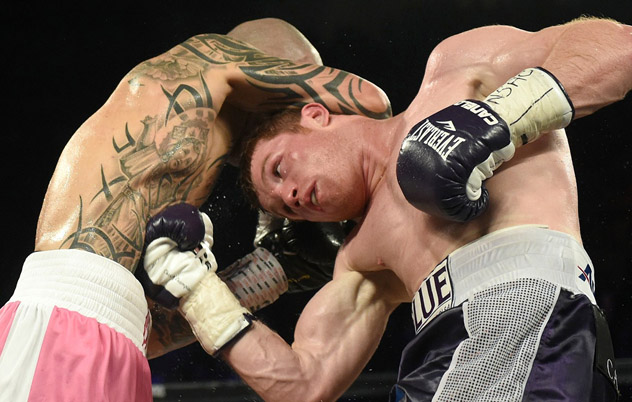
Photo by Naoki Fukuda
With a megafight showdown with Golovkin on the horizon for Alvarez, Gomez and De La Hoya had to decide whether the managed risk theory applied. Both agreed it did even though Khan’s speed is a factor to be concerned with.
“We took some chances with Canelo in the past,” Gomez said. “You worry about those things but we have youth, speed and power on our side. That’s a big advantage for us. It was against Lara and Trout and Kirkland and Cotto. If you lose on the way up, that’s tough. Now he’s fighting champions and former champions so you know there’s risk. But we wanted a big name.
“Amir is recognized here and in Europe. His name was mentioned so many times with Floyd we felt we could make this into an event. The guy is fast and he can punch so there’s intrigue there and the negotiation was fairly easy. They were very frustrated with the people who didn’t deliver for them several times. If he’d gotten the Floyd fight, he wouldn’t be fighting Canelo. If he got the fights he was promised, we don’t get to make this fight. They felt passed over. Amir had been dying for a big fight. We knew him personally. So the deal got made.
“When you make a match like this and your fighter is such a major part of your company there’s pressure, but Don Chargin taught me that as long as the advantages outweigh the risks it puts you at ease. Can he lose? Sure, because its sports. There’s always a winner and a loser. But you study the opponent. Then you go down a checklist and as long as six or seven of the 10 things are to your advantage, let your fighter do his job.”
Come May 7, Canelo Alvarez’s job is the same as it has always been: It’s to win. But his outsized importance for Golden Boy’s future and boxing’s makes clear he’s not just fighting for himself any more. He’s fighting to become the new face of his sport.
“Canelo is the biggest star in the sport and he’s only getting better,” De La Hoya said when the fight was announced. “Those who predicted he would take an easy fight for his first defense have been proven wrong once again.”


